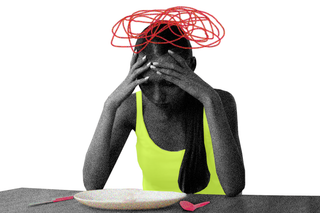
Scientists Link Specific Eating Disorders to Different Kinds of Childhood Trauma
The findings bolster the argument in favor of employing trauma-informed care as part of treatments for eating disorders.

The fact that experiencing childhood trauma can lead one to develop eating disorders is something past research has established. Now, a new study has been able to link different diagnoses of eating disorders to specific patterns of trauma one went through in childhood.
Published in the Journal of Eating Disorders, the study is based on a survey of more than 1,000 adults being treated for different eating disorders at two private treatment facilities in the U.S. Upon comparing the prevalence of childhood trauma among the participants — with a nationally representative sample of over 200,000 adults — the researchers found people with eating disorders to have reported higher rates of sexual abuse, parental divorce, or living with an individual who struggles with one form of mental illness or another.
“The number of [adverse childhood experiences (ACEs)] experienced by those with an eating disorder was higher than among those in the general population… We also wanted to compare differences in ACEs among different eating disorder diagnoses,” explained lead author Renee Rienecke from the department of psychiatry and behavioral sciences at Northwestern University.
Compared to individuals living with anorexia nervosa who restrict their food intake to maintain their weight, those with a binge-eating disorder were found to be more likely to have a history of physical abuse, besides reporting higher rates of general childhood trauma. Similarly, the researchers found participants living with bulimia nervosa reported a higher degree of household substance abuse, while those with other specified feeding or eating disorder (OSFED) mostly reported experiencing emotional abuse.
Related on The Swaddle:
For People With Poor Impulse Control, Instant Food Delivery Apps Can Kickstart Disordered Eating
Rienecke clarified, however, that “these results are just associations — we were not examining any causal explanations for why certain ACEs might be associated with certain eating disorders.” But overall, the findings bolster the argument in favor of employing trauma-informed care as part of treatments for eating disorders. As Rienecke adds, “A history of trauma can negatively impact treatment outcome[s] for eating disorders, so it is important to have a good understanding of the prevalence and extent of trauma in this population.” The value of the study, then, might lie in its ability to refine trauma-informed approaches for people struggling with eating disorders.
It is important to bear in mind, though, that “it’s not always the most obvious trauma that leads to serious eating disorders like bulimia and anorexia nervosa. Even school, home, and job transitions can prove to be devastating to a person’s self-worth, resulting in [the] mistreatment of their own body,” the National Institute for the Clinical Application of Behavioral Medicine (NICABM) states on its website.
A 2012 study had also found that the lack of support from one’s family — to help them cope with traumatic experiences — is often what paves the path for life-long eating disorders.
“I developed bulimia when I was a teenager… Those days, I was constantly called fat by my peers, who bullied me too; even at home, there were a lot of comments about my weight,” Tanisha, 26, who struggled with bulimia, told The Swaddle last week. “I respond to stress by binging and then making myself throw up… My eating disorder had started off as a coping mechanism; it still is, albeit a very unhealthy one.”
Related on The Swaddle:
What It’s Like To Live With: An Undiagnosed Eating Disorder
Eating disorders were already on the rise before the pandemic struck, with their prevalence having “increased over the study period from 3.5% for the 2000–2006 period to 7.8% for the 2013–2018 period. But since 2020, there has been a surge in disordered eating among young people, as the Clinical Trials Arena reported this February. And for people who were already trying to recover from eating disorders before everyone found themselves in the middle of a global health crisis, the struggle worsened.
At this juncture, studies like the present one, which improve our understanding of eating disorders, have become extremely important to mental healthcare. Yet, as Rienecke says, “Many questions still remain to be addressed: why do patients with binge eating disorder have higher rates of ACEs than patients with restrictive eating disorders? Why are certain eating disorder diagnoses associated with certain types of ACEs? Why do some people who experience ACEs go on to develop an eating disorder as opposed to, for example, a depressive disorder? Would public health efforts at reducing ACEs lead to a corresponding decrease in the development of mental health disorders later in life?”
Perhaps, further research into the association between different eating disorders and specific patterns of trauma will equip scientists to answer Rienecke’s questions. In doing so perhaps treatment options for people struggling with disordered eating can also be streamlined or, at the very least, improved.
In the meantime, the present study serves as yet another reminder of just how malleable our psyche us, and how we are but products of our circumstances. “It’s fascinating to think that physical malnourishment may reflect a lack of emotional nourishment in a traumatic childhood,” NICABM states, leaving readers with this nugget for thought: “Is it what you’re eating… or what’s eating you?”
Devrupa Rakshit is an Associate Editor at The Swaddle. She is a lawyer by education, a poet by accident, a painter by shaukh, and autistic by birth. You can find her on Instagram @devruparakshit.
Related


Food and Drinks Are Sweeter, More Harmful Now Than 10 Years Ago: Study
